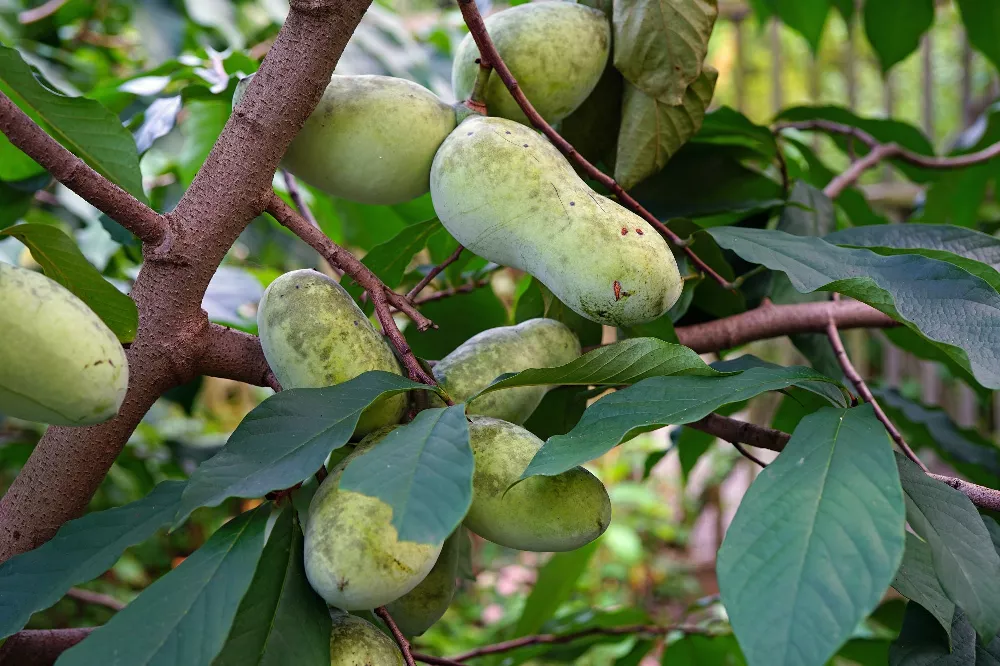- Home >
- Edible Plants >
- American Pawpaw Trees
American Pawpaw Trees for Sale
- Ships in 1-2 days
- 1-Year Warranty Eligible
- Pots or accessories are not included unless specified in the product options.
Shipping Details:
Once your order is shipped, you’ll receive an email with a tracking number and estimated delivery date. Most orders ship immediately, but some items are seasonal and may only ship in spring or fall. These products are noted on the website.
The American pawpaw (Asimina triloba) is a small fruit-producing tree native to eastern North America. The deciduous tree grows into a cone-like shape, producing large, yellowish-brown fruits. The species belongs to the Annonaceae plant family, famous for unique fruits like the soursop, custard-apple, and sweetsop.
- Pawpaws are the biggest edible fruits native to the U.S.
- The fruit features a creamy tropical flavor similar to bananas and pineapples.
- Pawpaw fruits are a rich source of vitamin C, iron, magnesium, and manganese.
Plant Care
Sunlight

For optimal fruit production, plant this tree in an area where it will receive at least six hours of direct sunlight per day.
Watering
Young American pawpaw trees should be watered frequently. Once established, they only need to be watered once per week.
Fertilizing

An all-purpose 10-10-10 fertilizer works well with American pawpaw trees.
Planting and Care
Planting instructions
The pawpaw is usually found in the understory of North American forests, but to improve fruit production you should make sure they receive as much sunlight as possible. To plant, start by digging a hole as deep as the root ball and three times as wide. Place your tree in the hole, leveling it with the ground before backfilling the hole with dirt. Tamp the soil down lightly and give the transplant a thorough watering. Add a layer of mulch around the tree to contain soil moisture as the tree establishes itself.
Watering and nutrients
After the initial planting, your American pawpaw trees will require frequent waterings. Apply a deep, thorough watering whenever the top inch of soil becomes dry. Once your tree matures and starts bearing fruit, you can scale back your watering schedule to approximately once per week. Applying mulch as needed will help reduce the number of waterings that your pawpaw trees require. To promote big, juicy fruit growth, apply a layer of all-purpose fertilizer or compost up to twice per year.
Pollination
In general, pawpaw trees are not usually self-fertile. For this reason, planting multiple pawpaw trees in an area will increase pollination and fruiting rates. The species may have trouble pollinating with only the help of bees, so some gardeners have turned to attracting flies to their trees. This can be done using road kill or food scraps. Pawpaw trees can also be hand pollinated if necessary — this is also a great way to cross two varieties of pawpaw trees.
Pruning
Pruning your pawpaw trees is a recommended practice that can help form them into a single-trunk growth pattern. Before the dormant period of winter, find the strongest leading branch and remove any weaker leaders. Pawpaw trees can spread through suckers, which are new growths that emerge from the original tree’s root system. These can be pruned away to prevent a pawpaw hedge from forming. You may also wish to perfect the tree’s shape through pruning, as they are easily formed into rounded, cone-like formations.
Pests, diseases, and animals
Your American pawpaw trees may experience some fungal diseases, such as powdery mildew or black spot. Powdery mildew won’t kill your trees, but it may harm their foliage and slow down their growth. Black spot will show up as black growths on the fruit and foliage of your trees. You can remedy both of these diseases by pruning the infected areas and using a copper-based fungicide. Dispose of the diseased branches carefully, as they can spread the fungus to other plants. Some insects and animals may be attracted to the fruits, but they don’t usually do enough damage to warrant concern.
Harvesting
American pawpaw trees will begin bearing fruit after about five years of growth. Pawpaws will begin to ripen toward the end of summer, starting in August and lasting until the first frost. Ripe fruits have turned from green to a yellowish-brown, and they are easily plucked from the tree. But you shouldn’t allow the fruits to ripen for too long, as this may lead to an astringent taste. Also, if you wait for the pawpaws to fall on their own, wildlife may get to them first — you can always let them ripen on a counter or in a paper bag instead of waiting for the perfect opportunity to pick them.
FAQs
How fast do pawpaw trees grow?
Pawpaw trees have a moderate growth rate of approximately one to two feet per year. Light pruning in the off-season can promote more vigorous growth throughout the summer. They grow into a rounded pyramid shape with an average height and width of about 15 feet. Individuals planted in perfect conditions may grow to over 30 feet tall. Once the trees begin flowering, their yearly growth will slow down as they focus on fruit production. This transition occurs around the fifth year after being planted.
Are pawpaws safe to eat?
Commercially-grown pawpaws may contain pesticides or other unwanted chemicals, but home-grown fruits are generally safe to eat. Some people have allergic reactions to the fruit, so proceed with caution if you have a history with food allergies. Never consume the skin or seeds, as these contain low levels of toxins that can harm humans. Consume the fruits in moderation and you should not experience any issues. Their flavor is custard-like and tropical, often being compared to mangos, pineapples, and bananas.
Are pawpaws the same as papayas?
Pawpaws and papayas share many similarities and are often thought of as the same fruit. This is a misconception, however, as the two trees are completely different species: Asimina triloba and Carica papaya. The papaya tree grows to heights of over 30 feet, which is over twice the size of the average pawpaw tree. The fruits are similar in appearance, both being oblong and melon-shaped, but papayas are almost three times the size of pawpaws and have a less-creamy flavor.
Can I grow a pawpaw tree from seed?
Pawpaw trees can technically be grown from seed, although this is not a recommended practice for home gardeners. Seeds collected from commercially-grown fruit are unlikely to grow into the same tree, as it may take on characteristics from either of the original tree’s parents. As a result, fruit production and overall growth may suffer. Nurseries are able to provide tried and true cultivars that produce consistent results. In addition, planting a pawpaw sapling will give you a headstart on growth, allowing you to harvest fruits a year or two earlier than planting from seed.








